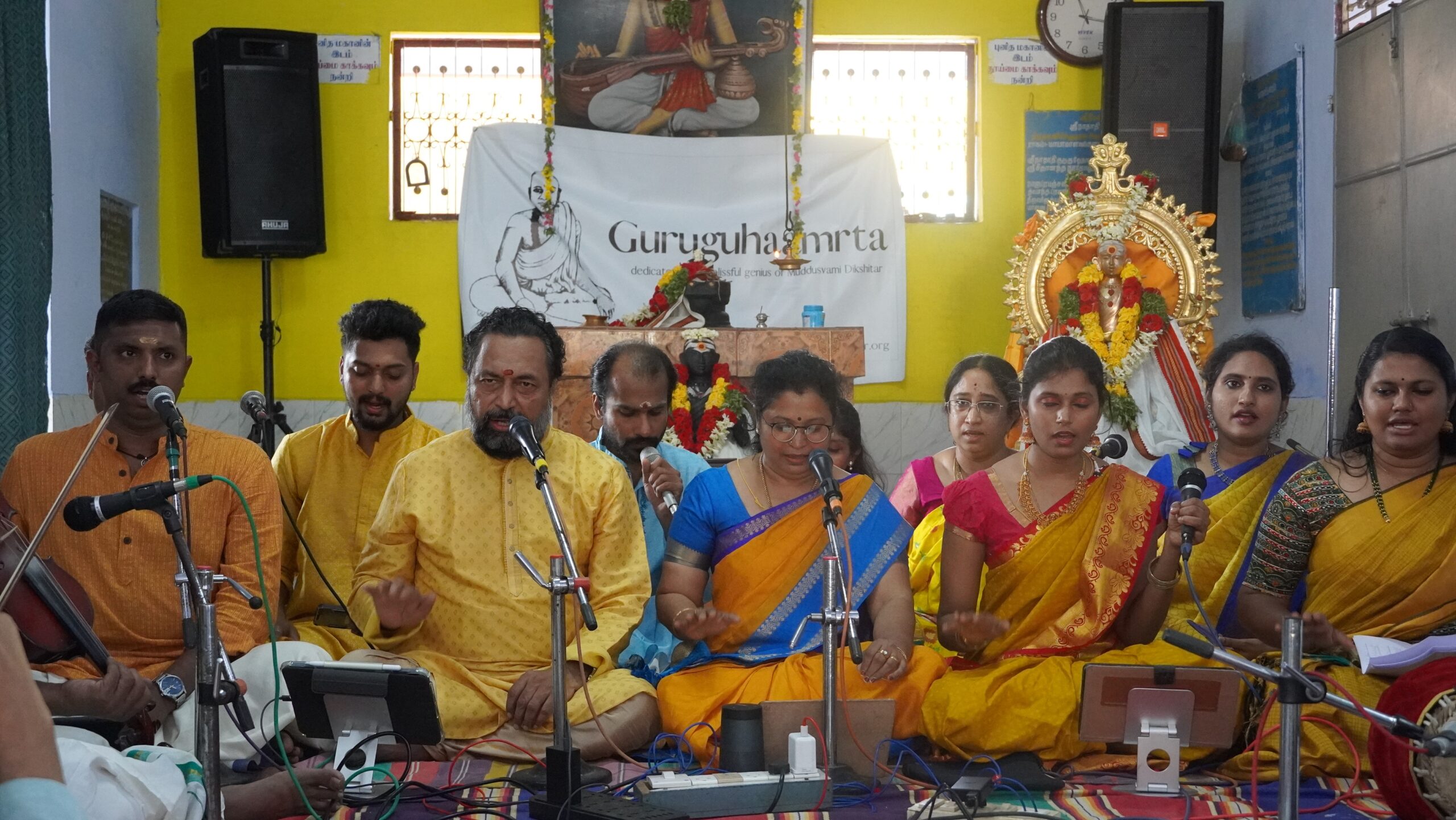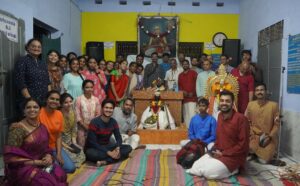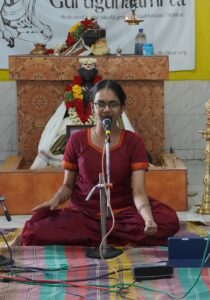The Dikshitar Aradhana at Ettaiyapuram is held in a small hall that is as unostentatious as the samadhi it houses.

Shertalai Ranganatha Sharma group at Dikshitar Aradhana. (Courtesy: Guruguhaamrta)
A buzz in the hot air envelopes the small town of Ettaiyapuram in the Thoothukodi district of Tamil Nadu.
The epicentre of the excitement is an unremarkable building next to the bus stand.
You can hear music punctuated with animated chatter at the entrance festooned with banana leaves.
“What’s your sruti?” “C-sharp.”
“Amruthavarshini group, be ready. You’re up next.”
The occasion is the Dikshitar Aradhana, organized every March at the samadhi or memorial, the final resting place of Muthuswamy Dikshitar, the legendary composer of Carnatic music.
The gathering is the brainchild of the Carnatic vocalist G Ravikiran and is organised by Guruguhaamrta, a trust dedicated to Dikshitar.
Dikshitar was born in Tiruvarur, near Thanjavur, on 24 March 1775. The poet and composer lived and travelled widely throughout India. He composed over 500 songs, all bearing his ‘mudra’ or signature name, Guruguha.
Thayagaraja and Shyama Shastri together with Dikshitar form the Trinity of Carnatic Music.
Dikshitar went to Ettaiyapuram at the invitation of its zamindar when he passed away in October 1835.

Musicians at the Aradhana (Courtesy: Guruguhaamrta)
“Dikshitar has always fascinated me,” says Ravikiran. “Learning his compositions is almost like love at first sight. There’s something about them that draws you in.”
According to the singer, each Trinity member’s music is unique. “The texture is different, the sounding is different,” he says.
He gives an example by singing a line from a Dikshitar composition and how it might have sounded had Thyagaraja composed it.
This love for Diskhitar’s music spurred Ravikiran to start the Dikshitar Aradhana at Ettaiyapuram. “We needed a forum to understand Diskhitar’s work. We have the Thyagaraja Aradhana at Thiruvaiyar [an annual celebration where hundreds of musicians gather to sing his pancharatna kritis]. So I thought we should do something here,” says the musician.
The annual event began in 2012 when Ravikiran invited some of his musician friends to Ettaiyapuram to sing at the composer’s samadhi. Ten people turned up.
The gathering has since grown from strength to strength. This year, about 150 people participated in the 16 March gathering.
Barring a few exceptions like me, most were musicians in their teens and 20s.
Senior artists who provided significant heft to the event included Shertalai Ranganatha Sharma, Sangeetha Sivakumar and TM Krishna, whose Sangita Kalanidhi award was announced the day after this event.
Ettaiyapuram feels like the proverbial town in the middle of nowhere. Once Guruguhaamrta announces the date of the Dikshitar Aradhana, musicians make their own arrangements to reach the nearest town, Kovilpatti, 14 km away.
The trust takes over logistics, including travel from Kovilpatti to Ettaiyapuram, food, acoustic arrangements at the venue, etc.
A small hall hosts the Dikshitar Aradhana at Ettaiyapuram. It is as unostentatious as the samadhi it houses.
Posters in Tamil line the walls, each with the words of one of Dikshitar’s compositions and its meaning. Colourful cotton dhurries are spread out on the floor. There is no formal stage.
A spirit of camaraderie pervades the intimate, informal gathering. After each performance, there is a short burst of applause. Someone pats another on the back, congratulating them on a good performance.
People spill out to confer with their fellow musicians. There is laughter and conversation, and music suffuses it all.
Vignesh Krishnamurthy, a Chennai-based vocalist in his late 20s, has participated in the Dikshitar Aradhana since 2018.
As a young musician, he feels the usual pressures of performing at a concert are absent when singing at Ettaiyapuram. “Here, the focus is not on me. Rather, the music is an offering to Diskhitar,” he says.
Bengaluru-based Niharika Balaji, who is still in high school, was participating in the event for the first time. “The experience was very good,” she smiles shyly.
The number of young musicians in the gathering belies the common perception that Carnatic music is unpopular with Gen Z.
Vignesh believes social media has been instrumental in popularising it among youth. “Till the mid-2000s, the only way to listen to music was through cassettes and CDs, or by going to concerts,” he says.

Aishani (Courtesy: Guruguhaamrta)
“But with the rise of YouTube as a platform for music, there is now enough content to last you a lifetime. And young people are the ones who tend to use YouTube and Instagram.”
At the same time, he acknowledges that some do feel a disconnect with the music because most of the songs are devotional, written several hundred years ago, and in a language – often Sanskrit – that many young people may not understand. Yet, for him, and clearly for the many at Ettaiyapuram, the art form’s melodic and lyrical aspects are captivating.
During the Aradhana, soloists, veena players, violinists, and groups performed 59 Dikshitar compositions, each singing one or sometimes two or three songs.
As Ravikiran pointed out, nowhere else could you have heard this unique line-up comprising only Dikshitar melodies.
I agreed with Ravikiran that it had indeed been “mentally refreshing.” Sometime in the future, he hopes to have music performed at the samadhi at least one day of every month.
But for now, it was time for the last performer of the day, TM Krishna, to take the mike.
A hush fell over the crowd as the virtuoso began with a superb rendering of the song Thyagaraja yoga vaibhavam and followed it with two more Diskhitar compositions.
And then, as the sun dipped low in the western sky, everyone in the hall together sang the last song of the Aradhana, the Dikshitar composition, Shri Kamalambike.
(The writer is a Bengaluru-based freelancer and Convenor of INTACH Bengaluru Chapter. Views are personal.)

Mar 21, 2024

Mar 21, 2024

Feb 09, 2024

Dec 26, 2023

Aug 11, 2023

Apr 28, 2023